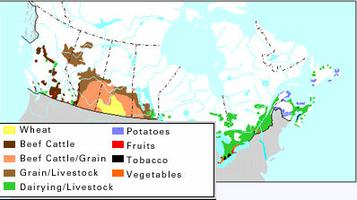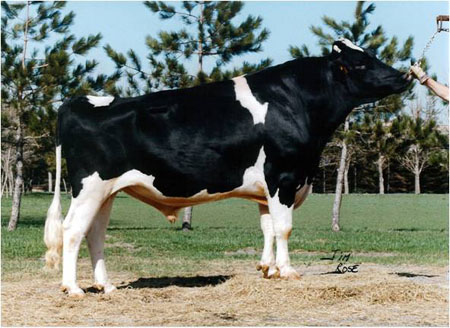
Dairy Farming
Dairy cattle (family Bovidae, genus Bos) are breeds of cattle raised for their ability to produce large quantities of milk with high butterfat, protein, calcium, casein and sugar content. In 1992 Canada had some 1.9 million milk cows and dairy heifers, about 73% in Ontario and Québec. Between 1951 and 1971, the number of dairy farms declined from 451 000 to 55 400, and to 28 900 by 1991. At the same time, herd size and production per cow increased; hence, production output has been maintained.
About 60% of the milk produced is processed into butter, cheese and skim milk powder; the remainder is consumed in liquid form. Canadian dairy products for domestic consumption or export must meet stringent health and safety as well as quality standards imposed by Agriculture and Agri-Food Canada and Health Canada.
Per capita consumption of butter and condensed (or evaporated) milk has gradually decreased, although consumption of products such as specialty cheeses and yogurt has increased. Milk marketing boards ensure stable, orderly production and marketing of milk, thus benefiting producer and consumer. Producers can plan in advance, adopting modern animal-management, animal-breeding and financial techniques; consumers are provided with a range of dairy products at stable prices year-round.
The Canadian dairy industry uses 7 breeds of cattle: Holstein, Ayrshire, Jersey, Guernsey, Canadian, Shorthorn and Brown Swiss. These dairy breeds are distinguished from beef cattle by their triangular, elongated, tall body form.
Holstein Cattle
Holstein cattle, which originated in Holland and were introduced to Canada in 1881, today comprise over 85% of Canadian dairy cattle. The breed is characterized by its colour (shiny black and white), large size and exceptional milk production. Mature bulls weigh up to 1200 kg; mature cows, up to 750 kg. A mature cow annually produces an average of 8000 kg of 3.7% butterfat, 3.2% protein milk.
Ayrshire Cattle
Ayrshire cattle originated in Ayrshire, Scotland. They were introduced to Canada around 1821. The coat is light or dark red and white in varying proportions. Roughly 70% of Canada's Ayrshires are found in Québec. Bulls weigh up to 910 kg; cows, 570 kg. A cow annually produces about 6400 kg of 4.0% butterfat, 4.0% protein milk.
Jersey Cattle
Jersey cattle originated on Jersey Island and were brought to Montréal in 1868. Jerseys are a fawn colour, except along the spine, around the muzzle and on the inside of the legs, where they are a paler shade. Bulls are darker than cows and some strains produce offspring with white markings. Bulls weigh up to 725 kg; cows, 500 kg. Each cow produces about 5400 kg of milk annually.
Guernsey Cattle
Guernsey cattle, like Jerseys, were produced from Breton and Norman breeds. Developed on Guernsey Island, they were brought to Canada in 1876. Guernseys are comparable in size to Ayrshires, and buff in colour with distinctive white spots. A mature cow produces about 5800 kg of 4.6% butterfat, 3.6% protein milk annually.
Canadian Cattle
Canadian cattle were developed in Québec from cows imported from Brittany and Normandy by French settlers early in the history of New France. This breed is limited almost entirely to Québec. It is black or brown, although the back, muzzle and udder or scrotum are generally paler (sometimes yellow). Bulls weigh up to 770 kg; cows, 545 kg. A cow annually produces about 3800 kg of 4.4% butterfat, 3.6% protein milk.
Shorthorn Cattle
Shorthorn cattle originated in England and were first imported in 1832. They are considered a dual-purpose (milk and beef) breed; in Canada, all strains are registered in the same herd book. Shorthorns are red, white, roan or a mixture of red and white. Bulls weigh up to 1045 kg; cows, 770 kg. Cows annually produce about 4250 kg of 3.8% butterfat milk.
Brown Swiss Cattle
Brown Swiss cattle originated in Asia, were developed in Europe, particularly Switzerland, and were brought to Canada in 1888. These cattle mate well with beef breeds. Bulls weigh up to 1135 kg; cows, 700 kg. Mature cows will annually produce about 6600 kg of 4.1% butterfat, 3.5% protein milk.
Good nutrition, sound management and breeding are the major criteria of successful herd improvement and, in Canada, have led to an average increase of over 50 kg of milk per cow per year in the past decade. Generally, breeders select mainly for milk production, then for body conformation characteristics associated with production and longevity. Under the direction of the Canadian Milk Recording Board, a milk recording program is implemented by 7 producer organizations.
Criteria such as quantity, butterfat content and protein content of milk produced by each cow are periodically recorded and compared to conformation standards established by various breeder associations. This information is officially recorded (in herd books) for each breed and used for genetic evaluation of cows and dairy sires. Since most milk producers use artificial insemination, evaluation of bulls is of critical importance. A detailed file on production and conformation is kept for each bull used in insemination centres. Artificial insemination has played a key role in improving the productivity of dairy cattle.
New developments in animal reproduction will have a further impact. Embryo transfer is already practised commercially; the best dairy cattle are superovulated (forced to produce exceptional numbers of eggs at one time) and impregnated with the semen from exceptional bulls; embryo freezing and the cloning of embryonic tissues are also practised. Canada has achieved an international reputation for the quality of its dairy cattle and now exports bull semen as well as livestock. In 1992, for example, 15 000 purebred dairy cattle were exported, most of them to Mexico.
Embryo freezing facilitates our international cattle trade, and sperm and embryo sexing also offer enormous potential. Rapid developments in biotechnology will make it possible to increase productivity still further, through production of vaccines, hormones and certain nutrients.
Feed represents about 10% of the cost of milk production: in high-performance herds, nutrition and food management are the factors promoting highest production. Cattle are ruminants; ie, they have a 4-compartment stomach in which bacteria and protozoa break down fibrous plant material into usable nutrients. A high-performance dairy cow annually consumes roughly 75% of its nutrients as fibre-rich grasses. The Canadian climate imposes difficult conditions on feed production and storage, and optimal use of grasses is a challenge. Milk production is increasing in all regions which are suitable for livestock feed production.
Increased productivity has resulted in higher frequency of mammary, digestive and reproductive disorders. Infertility and sterility are the 2 major reasons for culling dairy cattle. The causes of these disorders are complex, and a great deal of research is conducted into reproduction problems and mammary disorders. Detecting when the cow is in season continues to be a major concern for producers.

 Share on Facebook
Share on Facebook Share on X
Share on X Share by Email
Share by Email Share on Google Classroom
Share on Google Classroom



